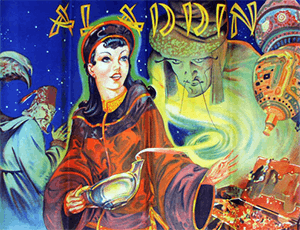Aladdin (fairy tale)

A tale of the Arabian Nights series and a Public Domain Character that has been adapted countless times, most recently popularised by the Disney version added to the Disney Animated Canon in 1992.
Like most folktales, "Aladdin" has undergone some major revisions, but the original story is as follows: Aladdin is a poor man from a Chinese city (Chinese In Name Only. The setting is completely Islamic). One day, an evil Maghreb sorcerer approaches him, claiming to be his father's brother. He gives Aladdin a ring and tricks him into entering a booby-trapped magic cave to retrieve a fancy oil lamp, but when Aladdin insists on getting out of the cave before handing over the lamp, the sorcerer flies into a rage and tosses him back down into the cave. Fortunately for Aladdin, the ring the sorcerer lent him is a Magic Ring that, when rubbed, releases a Djinni who brings him home, along with the lamp. When he gets home, Aladdin's mother starts cleaning the lamp, releasing a far more powerful Djinni who grants Aladdin his every wish.
Aladdin wishes for riches and an enormous palace, which win him the hand of the Emperor's daughter. However, the sorcerer learns of Aladdin's good fortune and plots to steal the lamp. He tricks Aladdin's wife into trading an old lamp for a new one and, not knowing about the power of the lamp, she does. The sorcerer then wishes for Aladdin's palace, along with his wife, to be moved to Maghreb.
Aladdin despairs, but all is not lost, because he still has that magic ring. While that Djinni can't simply undo the lamp Djinni's magic, he transports Aladdin to his palace where he frees his wife, rescues his castle, beats the bad guy, and gets his lamp back.
A version of the tale can be read here
- Aluminum Christmas Trees: Though the setting still has a case of Did Not Do the Research the setting isn't completely implausible because China does in fact have Muslims.
- Avenging the Villain: In the original version, the evil magician has a brother who is even more evil that comes to avenge him, but is vanquished by Aladdin with the lamp Djinni's help. This final episode is most often omitted from adaptations.
- Canon Immigrant: "Aladdin" wasn't originally a part of The Book of One Thousand and One Nights (a.k.a. the Arabian Nights); it was first printed in Antoine Galland's French translation of the book in 1710. Galland claimed to have heard it from a Syrian storyteller; but there is no hard evidence for that story and and there are those who believe he made it up himself.
- Disappeared Dad: The sorcerer from Maghreb mentions that he knew Aladdin's father but it was a ruse to get a somebody to help get the lamp.
- Did Not Do the Research: For a story about about a Chinese character, China as depicted here is an awful lot like the Middle East. This version of Imperial China has a Jewish merchant.
- It's a little more complicated than not doing the research; "China" could have referred to Central Asia, which was Muslim, or been a variant of "far away." After all, most other fairy tales claim to have happened "long ago and far away" yet have customs and objects more closely aligned to the time they were told. The fact that Aladdin was first translated (or written) by an 18th-century Frenchman, and the French fairy tale tradition is very well-known for doing this, may have something to do with that.
- Ethnic Magician: The evil sorcerer is Moroccan, while the main characters are Chinese.
- Evil Chancellor: Though not the main villain (as he is in Disney's Aladdin), the Grand Vizier is still something of a Jerkass Obstructive Bureaucrat who wants to get rid of Aladdin so that his own son can marry the princess.
- Genie in a Bottle: And also a magic ring.
- Green Lantern Ring: And lamp too. In fact, this is the inspiration behind the original Green Lantern, Alan Scott. Alan Scott's original planned name was Allan Ladd.
- Urban Legend. Martin Nodell picked the name out of the New York phone book. Bill Finger, the DC insider assigned to co-create with him, apparently added a lot of embroidery to the story.
- Jackass Genie: Surprisingly averted. Some versions of the tale have the more powerful Genie of the Lamp bound by a powerful curse that forces him to obey both the letter and the spirit of the wish -- to the point of refusing Aladdin when he's about to make a booby-trapped wish.
- Make a Wish: The entire premise.
- The Makeover: Aladdin goes from poor man to wealthy prince with the help of a Genie in a Bottle.
- Meaningful Name: Aladdin is the Anglicized form of Ala Al-Din which means "excellence of religion" or "light of Allah".
- Standard Hero Reward: Sort of -- Aladdin's wishes for wealth and a neat palace make him a viable husband for the princess, but he's already married to her by the time anything heroic happens.
- Race Lift: The origins of the story are usually ignored and the characters made Arab to fit in with the general "Arabian Nights Days" theme.
- Ring of Power: Which has a Djinn of its own.
- Spear Counterpart: To "Cinderella", arguably.
- Uptown Girl: Firmly in the Zany Scheme category, with Aladdin going to enormous lengths to get the rich princess.